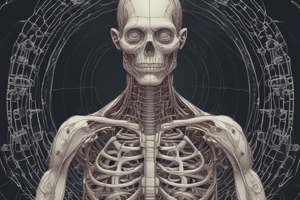Podcast
Questions and Answers
What is the primary function of the integumentary system?
What is the primary function of the integumentary system?
- Regulates body temperature and protects the body (correct)
- Produces hormones for regulation
- Facilitates movement and posture
- Transports nutrients and gases
Which of the following is NOT a type of tissue?
Which of the following is NOT a type of tissue?
- Connective
- Nervous
- Epithelial
- Organ system (correct)
Which organ system is primarily responsible for coordinating body activities and processing sensory information?
Which organ system is primarily responsible for coordinating body activities and processing sensory information?
- Nervous System (correct)
- Muscular System
- Endocrine System
- Cardiovascular System
What is the basic unit of life in biological organization?
What is the basic unit of life in biological organization?
Which system is involved in the elimination of waste and regulation of water balance?
Which system is involved in the elimination of waste and regulation of water balance?
Which component is NOT part of the skeletal system?
Which component is NOT part of the skeletal system?
What is the main purpose of the respiratory system?
What is the main purpose of the respiratory system?
How does the body typically maintain homeostasis?
How does the body typically maintain homeostasis?
Flashcards are hidden until you start studying
Study Notes
Overview of Human Anatomy and Physiology
- Anatomy: Study of the structure and organization of the body.
- Physiology: Study of the functions and processes of the body's systems.
Levels of Organization
- Cells: Basic unit of life; perform essential functions.
- Tissues: Groups of similar cells; four types:
- Epithelial
- Connective
- Muscle
- Nervous
- Organs: Structures composed of two or more tissue types; perform specific functions.
- Systems: Groups of organs working together; e.g., digestive system, respiratory system.
Major Organ Systems
-
Integumentary System
- Components: Skin, hair, nails
- Function: Protects body, regulates temperature, sensory perception.
-
Skeletal System
- Components: Bones, cartilage, ligaments
- Function: Supports body, enables movement, protects organs, stores minerals.
-
Muscular System
- Components: Skeletal muscles, smooth muscles, cardiac muscle
- Function: Facilitates movement, posture, and heat production.
-
Nervous System
- Components: Brain, spinal cord, nerves
- Function: Controls and coordinates body activities, processes sensory information.
-
Endocrine System
- Components: Glands (e.g., thyroid, adrenal), hormones
- Function: Regulates body functions via hormones, maintains homeostasis.
-
Cardiovascular System
- Components: Heart, blood vessels, blood
- Function: Transports nutrients, gases, hormones; removes waste.
-
Lymphatic System
- Components: Lymph nodes, lymph vessels, spleen
- Function: Defends against infection, maintains fluid balance.
-
Respiratory System
- Components: Lungs, trachea, bronchi
- Function: Facilitates gas exchange (oxygen and carbon dioxide).
-
Digestive System
- Components: Mouth, esophagus, stomach, intestines
- Function: Breaks down food, absorbs nutrients, eliminates waste.
-
Urinary System
- Components: Kidneys, ureters, bladder, urethra
- Function: Eliminates waste, regulates water and electrolyte balance.
-
Reproductive System
- Components: Male (testes, penis) and female (ovaries, uterus) organs
- Function: Produces gametes, hormones, and supports reproductive processes.
Homeostasis
- Definition: Maintenance of a stable internal environment despite external changes.
- Mechanisms:
- Feedback loops (negative and positive)
- Regulation of temperature, pH, hydration, and electrolyte levels.
Interrelationship of Systems
- All systems work interdependently to maintain bodily functions.
- Example: The respiratory and cardiovascular systems collaborate to ensure oxygen delivery and carbon dioxide removal.
Anatomy and Physiology
- Anatomy: Study of the structure and organization of the human body - how it is built.
- Physiology: The study of how the body functions
Levels of Body Organization
- Cells: The smallest unit of life, performing essential functions.
- Tissues: Made of similar cells, grouped together for a common function. There are four main types:
- Epithelial: Covers and protects
- Connective: Supports and binds
- Muscle: Provides movement
- Nervous: Communication
- Organs: Composed of different types of tissues working together, e.g., the heart.
- Systems: Groups of organs working together, e.g., the circulatory system.
Major Organ Systems
- Integumentary System:
- Components: Skin, hair, nails
- Function: Protects the body, regulates temperature.
- Skeletal System:
- Components: Bones, cartilage, ligaments
- Function: Supports the body, enables movement, and protects organs.
- Muscular System:
- Components: Skeletal muscles, smooth muscles, cardiac muscle
- Function: Enables movement, maintaining posture, and heat production.
- Nervous System:
- Components: Brain, spinal cord, nerves
- Function: Controls and coordinates body activities, processes sensory information.
- Endocrine System:
- Components: Glands (thyroid, adrenal), hormones
- Function: Regulates body functions through hormones and maintains homeostasis.
- Cardiovascular System:
- Components: Heart, blood vessels, blood
- Function: Transports nutrients, gases, hormones and removes waste.
- Lymphatic System:
- Components: Lymph nodes, lymph vessels, spleen
- Function: Defends against infection, maintains fluid balance.
- Respiratory System:
- Components: Lungs, trachea, bronchi
- Function: Facilitates gas exchange (oxygen and carbon dioxide)
- Digestive System:
- Components: Mouth, esophagus, stomach, intestines
- Function: Breaks down food, absorbs nutrients, and eliminates waste.
- Urinary System:
- Components: Kidneys, ureters, bladder, urethra
- Function: Eliminates waste, regulates water and electrolyte balance.
- Reproductive System:
- Components: Male (testes, penis) and female (ovaries, uterus) organs
- Function: Produces gametes, hormones, and supports reproductive processes.
Homeostasis
- Definition: Maintaining a stable internal environment despite external changes.
- Mechanisms:
- Feedback loops: Negative to restore balance, positive to enhance change.
- Regulation of body temperature, pH, hydration, and electrolyte levels.
Interrelationship of Systems
- All organ systems work together to maintain bodily functions.
- Example: The respiratory and cardiovascular systems collaborate to ensure oxygen delivery and carbon dioxide removal.
Studying That Suits You
Use AI to generate personalized quizzes and flashcards to suit your learning preferences.



